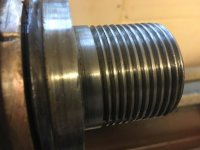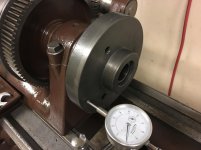RCPDesigns
Hot Rolled
- Joined
- Sep 3, 2014
- Location
- Atlanta GA.
I need some help with my 1898 Hendey. I have completed the restoration and have started working on getting the machine tuned in. Things have gone quite well but I'm stumped on a problem with the spindle. When I initially put the 3-jaw chuck on and measured runout it was way up there.. probably around 25 thousandths. With the help of forum member Joe, I worked on getting the bearings to fit properly. I am at the point now where I can put a 2x4 under the chuck and lift with all my might and not get more than 2 thou movement.
While I was working on the bearings I measure the runout of the spindle at the end of the threads (close the the headstock bearings) and was happy to see it was well under 2 thou. I then measured inside the spindle and was surprised to see it was 10 thou. It was (to me at least) interesting to note that there was a definite 'high' spot (10 thou) and a definite low spot (0 thou) and these two spots were 180 degrees apart. I worked more on the bearings, tried shims, did everything I could think of but each time I measured the inside of the spindle the reading was 100% the same, 10 thou out and high/low spots hadn't moved (I marked them).
At this point I thought that maybe someone had tried to change the taper (it seems to be close to a MT4) and messed the job up and made the taper off-center. Since the base of the threaded area was reading less that 2 thou I was hopeful that when I put the chuck on things would be OK. Unfortunately I noticed that the threads themselves seemed to be moving up and down but I wrote that off to an optical illusion. When I put the 3-jaw back on I was disappointed to find that the same 20 thou runout was still there. I measure the runout of the back plate and it appeared to be about 10 thou so part of the additional chuck runout is probably due to the chuck to back plate fit. It is quite possible that was always bad.
I'm not sure what to do at this point. I know that I can just live with the 10 thou as is and get a 4-jaw chuck. (right??) I could probably figure a way to mount an MT4 cutter and reamer in the compound or TS and re-cut the taper in the spindle. I plan to get an ER40 Collet Chuck holder with MT4 taper for holding small part so I'll need the inside of the spindle to run true.
Hopefully there is something I'm missing here? I can't figure out what happened to the the spindle nose. I have measured runout all along the spindle and it is always sub 2 thou, but the threaded part of the nose is 10 thou and visually noticeable. It looks like maybe the threads are a little rounded and I guess someone could have damaged it or maybe tried to re-thread it and got it off center then. Speaking of that... is it possible to cut the threads again? Maybe same pitch but a slightly smaller diameter? I don't have the skill to do that but I could probably find someone that could come over and help. I would assume that cutting them on the spindle right "in place" so to speak would be the way to go?
I will post a link to a short video showing the runout. Update: video is here: Hendey spindle runout - YouTube
While I was working on the bearings I measure the runout of the spindle at the end of the threads (close the the headstock bearings) and was happy to see it was well under 2 thou. I then measured inside the spindle and was surprised to see it was 10 thou. It was (to me at least) interesting to note that there was a definite 'high' spot (10 thou) and a definite low spot (0 thou) and these two spots were 180 degrees apart. I worked more on the bearings, tried shims, did everything I could think of but each time I measured the inside of the spindle the reading was 100% the same, 10 thou out and high/low spots hadn't moved (I marked them).
At this point I thought that maybe someone had tried to change the taper (it seems to be close to a MT4) and messed the job up and made the taper off-center. Since the base of the threaded area was reading less that 2 thou I was hopeful that when I put the chuck on things would be OK. Unfortunately I noticed that the threads themselves seemed to be moving up and down but I wrote that off to an optical illusion. When I put the 3-jaw back on I was disappointed to find that the same 20 thou runout was still there. I measure the runout of the back plate and it appeared to be about 10 thou so part of the additional chuck runout is probably due to the chuck to back plate fit. It is quite possible that was always bad.
I'm not sure what to do at this point. I know that I can just live with the 10 thou as is and get a 4-jaw chuck. (right??) I could probably figure a way to mount an MT4 cutter and reamer in the compound or TS and re-cut the taper in the spindle. I plan to get an ER40 Collet Chuck holder with MT4 taper for holding small part so I'll need the inside of the spindle to run true.
Hopefully there is something I'm missing here? I can't figure out what happened to the the spindle nose. I have measured runout all along the spindle and it is always sub 2 thou, but the threaded part of the nose is 10 thou and visually noticeable. It looks like maybe the threads are a little rounded and I guess someone could have damaged it or maybe tried to re-thread it and got it off center then. Speaking of that... is it possible to cut the threads again? Maybe same pitch but a slightly smaller diameter? I don't have the skill to do that but I could probably find someone that could come over and help. I would assume that cutting them on the spindle right "in place" so to speak would be the way to go?
I will post a link to a short video showing the runout. Update: video is here: Hendey spindle runout - YouTube





